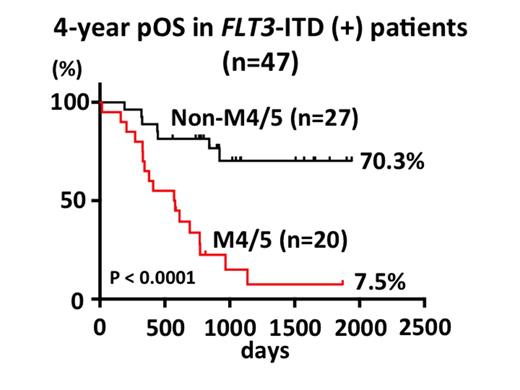Abstract
Background:
Although pediatric acute myeloid leukemia (AML) still has a poor prognosis, advanced risk-stratified chemotherapy and effective supportive care have improved the outcome, with the long-term survival rate of 60–70%. Comprehensive molecular analysis using next-generation sequencing identified the heterogeneity of this disease, suggesting that it would be difficult to increase the effectiveness of risk stratification. FLT3-ITD, accounting for 12–15% of pediatric AML, is a well-known predictor of poor prognosis and is used for risk stratification. However, recent studies have reported frequent co-occurrence of FLT3-ITD with other prognostic factors such as NUP98-NSD1, MLL-PTD, NPM1, and DEK-NUP214. These findings prompted us to reconsider the significance of FLT3-ITD and search for other factors that can identify a poor-prognosis subgroup in pediatric AML patients with FLT3-ITD.
Patients and Methods:
From 2006 to 2010, 485 de novo pediatric AML patients aged <18 years participated in the Japanese AML-05 study conducted by the Japanese Pediatric Leukemia/Lymphoma Study Group (JPLSG). A total of 369 samples were available for this study. All samples were centrally reviewed at diagnosis according to the FAB classification and cytogenetic analysis. FLT3-ITD was found in 47 patients (12.7%). Age and WBC counts were significantly higher in FLT3-ITD-positive than in FLT3-ITD-negative patients (p = 0.0016 and p = 0.0003, respectively). In contrast, the probability of overall survival (pOS) in FLT3-ITD-positive patients was significantly lower than that in FLT3-ITD-negative patients (4-year pOS: 41.3% vs 69.5%, p < 0.0001). Fusion gene and gene mutation analyses were performed for the detection of NUP98-NSD1, NUP98-JARID1A, CBFA2T3-GLIS2, FUS-ERG, DEK-NUP214, RUNX1-RUNX1T1, CBFB-MYH11, KIT, N-RAS, K-RAS, WT1, NPM1, and MLL-PTD.
Results and Discussion:
Survival analysis in FLT3-ITD-positive patients (n = 47) revealed that patients with FAB subtypes M4 and M5 (M4/5 patients; n = 9 and 11, respectively) had a much poorer prognosis than those with other FAB subtypes (non-M4/5 patients; n = 27; 4-year pOS: 7.5% vs 70.3%, p < 0.0001). Six of 9 FAB-M4 patients and all FAB-M5 patients died, indicating that the M4/5 patients are strongly associated with a poor survival in FLT3-ITD-positive patients. In M4/5 patients (n = 20), age was not statistically different (11.3 years vs 10.9 years, p = 0.5902), but the WBC count was significantly higher than non-M4/5 patients (110,200/ µL vs 26,200/ µL, p = 0.0176). In M4/5 patients, NUP98-NSD1 (n = 6), MLL-PTD (n = 3), DEK-NUP214 (n = 2), KIT mutation (n = 2), and WT1 mutation (n = 3) were repeatedly detected, and all patients with any of these aberrations died. Prognostic independence of NUP98-NSD1 and MLL-PTD remains to be determined because they are associated with a high incidence of FLT3-ITD. Meanwhile, 6 patients did not have any molecular aberrations, and 4 patients had a normal karyotype, suggesting the presence of cryptic fusion genes or unknown gene mutations. On the other hand, favorable genetic aberrations were frequent in non-M4/5 patients (n = 27). RUNX1-RUNX1T1 and NPM1 mutations were found in 3 and 5 non-M4/5 patients, respectively. All of these patients are still alive without a relapse, suggesting that the effects of FLT3-ITD are reversed by some favorable genetic aberrations, although the underlying mechanism remains unknown. Non-M4/5 patients who died (n = 7) included 1 patient each with NUP98-NSD1 and CBFA2T3-GLIS2; thus, further criteria are necessary to not misclassify these patients. Although it is unclear why the poor prognosis associated with M4/5 was not noticed to date, the possibilities are racial difference and the small sample size of Japanese cohort studies. In addition, the problem is that there are no promising treatments at present for patients with a very poor outcome, even if such a distinct subgroup is identified.
Conclusions:
We identified the prognostic significance of the FAB classification which stratified Japanese pediatric AML patients with FLT3-ITD into a very high-risk group and intermediate-risk group. The poor prognosis associated with NUP98-NSD1, MLL-PTD, and DEK-NUP214 may be worsened with the co-occurrence of FLT3-ITD and FAB-M4/5. We believe that these findings will help to develop not only a risk-stratified therapy, but also an epoch-making treatment for this poor-prognosis subgroup of pediatric AML.
No relevant conflicts of interest to declare.
Author notes
Asterisk with author names denotes non-ASH members.


This feature is available to Subscribers Only
Sign In or Create an Account Close Modal